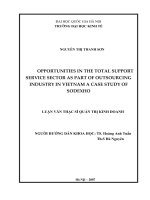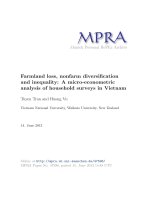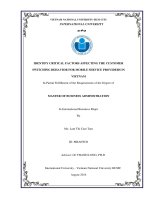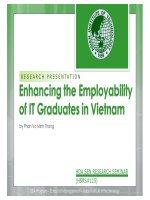Design principles of the micro learning for employee development the case of service industry in vietnam
Bạn đang xem bản rút gọn của tài liệu. Xem và tải ngay bản đầy đủ của tài liệu tại đây (1.74 MB, 94 trang )
VIETNAM NATIONAL UNIVERSITY, HANOI
VIETNAM JAPAN UNIVERSITY
NGUYEN QUYNH LIEN
DESIGN PRINCIPLES OF THE MICRO
LEARNING FOR EMPLOYEE
DEVELOPMENT: THE CASE OF SERVICE
INDUSTRY IN VIETNAM
MASTER'S THESIS
VIETNAM NATIONAL UNIVERSITY, HANOI
VIETNAM JAPAN UNIVERSITY
NGUYEN QUYNH LIEN
DESIGN PRINCIPLES OF THE MICRO
LEARNING FOR EMPLOYEE
DEVELOPMENT: THE CASE OF SERVICE
INDUSTRY IN VIETNAM
MAJOR: BUSINESS ADMINISTRATION
CODE: 8340101.01
RESEARCH SUPERVISORS:
Prof. Dr. MOTONARI TANABU
Dr. MAI ANH
Hanoi, 2021
ACKNOWLEDGMENTS
The master thesis is a great chance for me to check how to apply the knowledge
and skills that I learned in 2 years in university. I would like to give my gratitude to
those who have supported me to finish this paper.
Firstly, I would like to express my deepest gratitude to Dr. Mai Anh and Prof.
Dr. Motonari Tanabu who spent their time giving them valuable advice and guide me
during this period although he is occupied with his duties. No words can fully express
my gratitude to them for their patience, sympathy, encouragement, and precious
instruction and advice which support me to improve this research.
Secondly, I am also thankful for Prof. Dr. Matsui Yoshiki and Prof. Kurata
Hisashi spend time helping me to research my topic. I am grateful to all of them for
their valuable supports to me.
Thirdly, I am grateful to Vietnam Japan University (VJU) of Vietnam
National University, Hanoi, and Yokohama National University (YNU) create a
valuable opportunity for me to improve my knowledge and skills in research.
Fourthly, I send my thanks to all the Program Assistants of the MBA program,
Ms. Huong and Ms. Trang to support the administrative issues.
Last but not least, I would like to express my gratitude to my family and friends
who are always beside me to motivate me, give me precious support to surpass the
difficult time to finish the paper.
However, because of the limitation of knowledge and skills, time, there are
many things to be improved in this paper. Thus, I am so thankful to you for your
valuable advice to make it better.
Thanks and best regards
Nguyen Quynh Lien
TABLE OF CONTENTS
CHAPTER 1. INTRODUCTION ..............................................................................1
1.1. Research Background ......................................................................................1
1.2. Research Objectives .........................................................................................5
1.3. Research Methodology ....................................................................................7
1.4. Research Structure ..........................................................................................8
CHAPTER 2. LITERATURE REVIEW ................................................................10
2.1. The design principles of video-based microlearning ..................................10
2.1.1.
The general design principles (learning theories, ML activities) ..........10
2.1.2.
The design principles of the microlearning content ..............................16
2.2. Evaluation of the effectiveness of VM in developing employee
competency. ..............................................................................................................23
CHAPTER 3. RESEARCH METHODOLOGY ....................................................26
3.1. The study design .............................................................................................26
3.1.1.
The experimental study – the training program .....................................26
3.1.2.
The interview and small talk – the follow-up activities after training ..36
3.2. Participants .....................................................................................................37
3.2.1.
The experimental study – the training program .....................................37
3.2.2.
The interview and small talk – the follow-up activities after training ..40
3.3. Data collection and instruments ...................................................................40
3.3.1.
The experimental study – the training program .....................................40
3.3.2.
The interview and small talk – the follow-up activities after training ..41
3.4. Measurements ................................................................................................42
CHAPTER 4. DATA ANALYSIS AND FINDINGS .............................................45
4.1. Data description .............................................................................................45
4.2. Findings ...........................................................................................................46
4.2.1.
H1: VM is more preferred than other formats and makes employees
highly satisfactory..................................................................................................46
4.2.2.
H2: VM is suitable to train the first introduced, complex skills and
knowledge because it helps the employees to capture knowledge and skills, make
employees highly satisfactory ...............................................................................48
4.2.3.
H3: Shorter brevity of VM makes make employees highly satisfactory
but the VM brevity can be different for the different topic ...................................52
4.2.4.
H4: Interaction helps employees to capture knowledge and skills and
make employees highly satisfactory with VM ......................................................54
4.2.5.
H5: Assessment activities help employees to check, reflect their
knowledge of what they learned from VM, and make employees highly
satisfactory with VM .............................................................................................56
4.2.6.
H6: Technology platform makes the employees capture knowledge and
skills and make employees highly satisfactory with VM ......................................59
CHAPTER 5. DISCUSSION & CONCLUSION ...................................................70
5.1. Comparison with the literature review ........................................................70
5.2. Implications and contribution ......................................................................73
5.3. Limitation .......................................................................................................76
5.4. Future research ..............................................................................................77
5.5. Conclusion ......................................................................................................77
LIST OF TABLES
Table 2.1. Dimensions of microlearning contents ........................................................16
Table 2.2. A literature review of contents ....................................................................20
Table 2.3. A literature review of brevity ......................................................................21
Table 2.4. A literature review of interaction ................................................................21
Table 2.5. A literature review of assessment ................................................................22
Table 2.6. A literature review of technology ................................................................23
Table 2.7. Training effectiveness evaluation - Kirkpatric’s level ................................25
Table 3.1. Summary of the design of the training program .........................................26
Table 3.2. Training module summary ..........................................................................30
Table 3.3. Our design bases on DO-ID models ............................................................31
Table 3.4. Summary of training activity in the training program .................................35
Table 3.5. Interview information of the sample ...........................................................37
Table 3.6. Method of measuring hypothesis ................................................................42
Table 4.1. The satisfaction pre-survey result of VM compared other formats ............46
Table 4.2. The satisfaction result of VM ......................................................................47
Table 4.3. Frequency of response of satisfaction of VM .............................................47
Table 4.4. Comparison of the pre-test and the post-test result and standard score ......49
Table 4.5. Overall satisfaction of VM ..........................................................................50
Table 4.6. Frequency of response of the overall satisfaction of VM ...........................51
Table 4.7. The employees' opinion of the brevity of VM ............................................53
i
Table 4.8. The pre-test and the post-test result of training module 1 ...........................54
Table 4.9. The pre-test and the post-test result of training module 4 ...........................54
Table 4.10. The pre-test and the post-test result of training module 5 .........................55
Table 4.11. Satisfaction result of interaction ................................................................55
Table 4.12. Overall satisfaction of assessment activities in VM ..................................56
Table 4.13. Frequency of participants responses to assessment activities in VM .......57
Table 4.14. Overall satisfaction of the technology platform in VM ............................59
Table 4.15. Frequency of participants’ responses to the technology platform ............61
Table 4.16. Summary of all findings ............................................................................65
Table 5.1. Summary answers to the research sub-questions ........................................78
ii
LIST OF FIGURES
Figure 1.1. Structure of the study ...................................................................................9
Figure 2.1. Microlearning model (Dolasinski & Reynolds, 2020) ...............................14
Figure 2.2. DO-ID model – Didactic Requirements (Busse et al., 2020) ....................14
Figure 2.3. Kirkpatrick level (Mohamed et al., 2012) ..................................................24
Figure 3.1. Images of the training process of VM ........................................................33
Figure 3.2. Images of training materials .......................................................................33
Figure 3.3. Image of community activities ...................................................................33
Figure 3.4. Illustration of consistency structure of micro-videos .................................36
Figure 4.1. Gender information of the research sample ...............................................45
Figure 4.2. Position information of the research sample ..............................................45
Figure 4.3. Working experience information of the research sample ..........................45
iii
LIST OF ABBREVIATIONS
VM:
Video-based microlearning
BPO:
Business Processing Outsourcing
ML:
Microlearning
HR:
Human Resources
E:
Employee
ADDIE:
Analysis, Design, Development, Implementation, and Evaluation
ARCS:
Attention, Relevance, Confidence, Satisfaction
iv
ABSTRACT
The purpose of this study is to test and explore the design principles of videobased microlearning (VM) to improve employee competencies in the job. The research
methodology in this paper was the experimental strategy with observation and the
direct interview. We collected data from the employees who joined the leadership
training program in a company in Business Processing Outsourcing (BPO) industry.
Participants joined all 6 modules in the training program in 2 months (N=12), did a
pre-test and a post-test, and Likert-style pre-survey and post-surveys for each module.
We also performed the follow-up training activities by using direct interview and small
talk (N=11) and Likert style survey to have a deeper understanding of what factor of
the design principles and the effectiveness of these principles of VM in satisfying their
training program as well as increasing leadership skills and applying them in their
work. The employee competencies development was evaluated by the employee
satisfaction of training program and training result based on using the Kirkpatrick
evaluation model.
Based on the result, the design principles focus on the content aspect of VM:
brevity, interaction, assessment, and technology are 4 important design factors as the
previous papers. About the 5th factor – content, different from the literature review,
we can still use the VM to present the complex or the 1st introduced knowledge and
skills if we combined with other principles.
Thus, the recommendations for the design principles of VM to enhance
competencies are focusing on 5 factors of microlearning content (brevity, interaction,
assessment, technology, content) combined with applying learning theories and
general design principles like microlearning strategy and activities. This result is
considered as a reference source for the company designers to design VM used in
training activities, especially for the leadership training program, in the BPO industry.
Keywords: microlearning, video-based microlearning, design principles, employee
development, service industry, training effectiveness evaluation.
CHAPTER 1.
INTRODUCTION
The chapter gives general information about this paper. It includes 4 parts:
research background, objectives, methodology, and structure. First, why did we choose
this topic from the practical and theoretical issues? Organizations need to develop
employee competencies with resource limitations, the employees need to learn when
they need. Microlearning (ML) especially video-based microlearning (VM) is a
powerful strategy in learning and training to meet these needs but there is a lack of
guidelines for designing it. Next, we share that the research purpose was to give the
guidelines for the designers so the research objective was to study the design
principles of VM. We summarized that the design principles of VM included 3
aspects: aspect (1) learning theory application, aspect (2) microlearning activities,
aspect (3) microlearning content. 2 first aspects will be called the general design
principles part of VM. Aspect (3) microlearning contents were the main objects of this
research. In this chapter, we explained the reason why we did that. Next, we give brief
information on how to conduct the research. We researched the previous papers,
conducted the experiment study – training program and interview protocol for followup training activities. The research methodology part was described in more detail in
chapter 3. The last part mentions the paper was presented by which paper. Besides, to
clarify all contents and links among them, we added a figure at the end of this chapter
that summarized the main points in this work with the mindmap model. The readers
should view this figure first before reading detailed information.
1.1. Research Background
Microlearning has been recently considering as the key topic in employee
development in the organization. Microlearning has various definitions but generally
refers to small single content in short training time (Buchem & Hamelmann, 2010)
small chunks of information, solve the problem (Giurgiu, 2017), easy to access any
time anywhere via flexible technologies like mobile, laptop, web (Gabrielli, Kimani, &
Catarci, 2017). Microlearning has various forms such as video, flashcards,
gamification, poster,…(Mohammed, Wakil, & Nawroly, 2018). In this research, we
researched a video form called video-based microlearning (VM). The VM is defined
1
as a learning media tool designed and used in the training program, made based on
course objectives, and cooperated with the flipped classroom. Besides that, the VM
explains the key ideas of 1 topic in concentrated, audio, visual ways and lengthens less
than 30 minutes.
In various microlearning forms, we selected VM to research deeply in this
paper. The are 3 explanations for this choice. (1) The use of video to deliver training
content has become popular (Balslev, De Grave, Muijtjens, & Scherpbier, 2005;
Bishop & Verleger, 2013). (2) Video material is the most powerful training tool
because it provides visual and auditory information at the same time. This form is
effective than traditional classroom lectures, textbooks, audio (Letrud & Hernes,
2018), with the greatest impact to give users the ideas to think and act (Paul, 2016)
(Emerson & Berge, 2018). It is the most effective strategy for teaching and learning
when exploring instructional strategies (Hanshaw & Hanson, 2018). (3) It has benefits:
preferred learning tool (Mohammed et al., 2018), easily memorable knowledge
(Giurgiu, 2017), better attraction to learners, learning outcome increase (higher
performance), higher learning motivation (high satisfaction) (Adhipertama, Jampel, &
Sudatha, 2020).
The practical issues: More and more companies implement training programs
to develop employee competencies that partly impacts business results. To have an
effective job
performance, employee development means
developing their
competencies including attitude, knowledge, and skills which help the staff master job
behaviors (Emerson & Berge, 2018). The need for employee development becomes
more and more crucial because there is a shift among sectors. The labor force has
shifted increasingly from agriculture to services industry but there is a lack of a highly
skilled workforce (ILO, 2019). Especially, BPO (Business Processing Outsourcing)
sector is a potential emerging industry in Vietnam in recent years but it faces a
massive shortage of higher-skilled workforce (e.vnexpress.net, 2018). So the employee
development in the service industry is receiving increasing attention.
However, the companies have limited training budgets and trainers. According
to (HRDAcademy, 2019), training hour/employee in Vietnamese companies is 21-38
2
hours/year, equal to ½ average training hours/employees in the US companies
(equivalent to 42.1 hours), limited budget for training activities at 0.58% - 2.5% of
revenues. Morever, Ho (2016) suggested the majority of the training budget is
allocated to leadership training (Lacerenza, Reyes, Marlow, Joseph, & Salas, 2017).
Besides, in changing world, the employees need to learn continuously to meet the
demand of the job. However, they have the limitation of time and they expect to learn
anytime, anywhere when they need it (Paul, 2016).
Micro learning can satisfy the requirement of the company and staff about just
in time, cost-effective, updated, and the newest information, not impact on the daily
job: fits easily into employees’ workdays, allow employees to seek out & retain
information for themselves (Fox, 2016), bite-sized learning leads better business
outcomes (Giurgiu, 2017), quickly adapt to the employees’ updated needs, easily
absorb information (Paul, 2016), improve learning ability for up to 18% compared to
traditional method (Mohammed et al., 2018), develop competencies in the workplace
with cost reduction through distance learning, good design to deliver skills and
knowledge, increase competencies in workplace (Leong, Sung, Au, & Blanchard,
2021), for who has limited time to learn, best for reinforcing the concept already know
(Hanshaw & Hanson, 2018; Paul, 2016), follow-up or supplementary component of
the large training program(Hyo-Jeong Soa, 2020), more competitive because of just in
time and cost-effective training (Giurgiu, 2017; Leong et al., 2021). But microlearning
has also some difficulties with complex knowledge (Paul, 2016), not apply for 1sttime small content units and rather narrow topics (Fox, 2016), high-order thinking
skills (Jahnke, Lee, Pham, He, & Austin, 2020).
In brief, microlearning is an effective model for employee competency
development. It is a powerful tool if its design is suitable (Zhang & West, 2019). Then,
we consider what are the crucial design principles of microlearning to get the desired
training outcome. Design principles mean guidelines, fundamental advice for
designers to make pleasurable designs easily. These principles are based on
considering the instructional design and didactic design. The instructional design
refers to a systematic process of solving instructional and learning problems through
3
learning materials and activities to design a satisfying learning experience. The
designers often apply learning theories and problem-solving models when deciding on
design like training material, training process…(Molenda, Reigeluth, & Nelson, 2003).
The didactic design aims to a variety of concepts, theories, subjects, knowledge and
skills, methods, goals, assessments, or focus on the didactic triangle – the relationship
among trainers, trainees, contents (Hug, 2010). Thus, in our research, we consider
microlearning in a holistic perspective that applies many aspects.
The theoretical issues: The didactic design principles of microlearning focus on
content and activities (Buchem & Hamelmann, 2010). But little research on the design
principles for video-based microlearning (VM) for a leadership training program. The
first reason is that just only the research of leaders’ perceptions of mobile
microlearning and social learning in competency development (Hanshaw & Hanson,
2018) or other topics like science subjects (Adhipertama et al., 2020). The second is
that the contemporary design principles have focused on the general guidelines for
microlearning materials (Buchem & Hamelmann, 2010; Hug, 2005) or specific
guidelines for other tools such as video games (Giannakos, Chorianopoulos, &
Chrisochoides, 2014), graphic animation video (Weiyan, 2017). The third reason is
there is little research on microlearning in Vietnam (Leong et al., 2021). The fifth is
that microlearning is researched in some sectors in the service industry such as
Hospitality (Mary Jo Dolasinski, Joel Reynolds, 2020), aerospace and healthcare
(George Hanshaw & Janet Hanson, 2018), education (Made Chandra Adhipertama &
Nyoman Jampel & Gde Wawan Sudatha, 2020, Konstantinos Chorianopoulos &
Michail N. Giannakos, 2014), but there is little studies on BPO (Business Processing
Outsourcing).
In summary, to develop employee competency with the limitation of time,
money, we suggest using VM with design principles found out in this paper, in the
leadership training program for companies in the BPO industry.
4
1.2. Research Objectives
After researching the previous papers, we assumed that the design principles of
VM include 3 aspects: aspect (1) the learning theories application, aspect (2)
microlearning activities including process, models, learning communities such as the
usage of blended learning, social media, collaborative learning..., aspect (3) the design
principles of microlearning contents. There have been few papers that named these 3
aspects when designing. When talking about designing any forms of microlearning,
they often focus on the aspect (2) - activities and aspect (3) – contents (Buchem &
Hamelmann, 2010) or other material forms like video games microlearning, mobile
microlearning, infographics, gamification...(Hug, 2005, 2010; Hyo-Jeong Soa, 2020).
We would like to give 3 aspects because the following 3 reasons. The first reason is
that we found some previous papers mentioned the importance of applying learning
theories in designing training materials, process…. A paper said that theories of
multimedia learning are applied in microlearning design will maximize the
effectiveness of instructional communication and learning (Snelson & Elison-Bowers,
2007). Another paper emphasized applying learning theories and instructional design
models can bring effective instruction (Khalil & Elkhider, 2016). The second reason
might be their design standard from the only one-sided viewpoint of design experts
such as trainers, teachers… or the learners. However, we designed VM in the training
program from both sides designer (trainers) and the company employee (trainees) at
the same time and apply Kaizen attitude (improvement times by times). Both the
designers and trainees were cocreators in designing VM. Through an experimental
study – training program, we designed many videos but video by video, not all videos
at the same time. The next video was better than the previous video because it is
improved by not only the observation of designers when using it but also from the
feedback of trainees about materials in the survey. We stand out in holistic view and
continuous improvements when designing VM. This thinking way is close to some
learning theories. So the reason why we added more aspects (1) – the aspect of
psychology consideration. The third reason is that the principles of aspect (1) and
aspect (2) might be applied for all forms of microlearning, but not just only for video
5
form. For example, the motivation theory mentioned about gaining the learner's
attention is the 1st component of the ARCS model of motivation. Learner attention is
gained by using interesting graphics, animation…(Keller & Suzuki, 2004). Aspect (3)
might include some characteristics designed specifically for video forms. Besides that,
they were key parts of microlearning (Buchem & Hamelmann, 2010). Thus, in the
limitation of time and human resources, the design principles of aspect (1), (2) were
considered as the general, must-have design principles naturally applied in VM. The
paper partly showed the proof of the effectiveness of the principles. But the contents of
the research focused mainly on VM and its design principles in the aspect (3) –
microlearning contents which were evaluated effectively or not through the experiment
study – training program and the interview protocol. The effectiveness of design
principles was shown through training outcomes. The context to explore these aspects
was the VM used in the formal training program to develop competencies of the team
leaders up in the BPO service industry.
Thus, the research object was the design principles of VM in aspect 3 –
microlearning contents, built on the literature review and working experience which
were presented in detail in chapter 2 of this work. We answered the research questions:
“What are the crucial design principles of microlearning specifically used in the
training program in the service industry? And what factors of the design principles
influence the employee satisfaction and the training outcome including capturing
knowledge and skills and getting high training satisfaction?”. These questions will be
clarified through the following sub-questions:
• What is the preferred microlearning format?
• What is the suitable content for VM?
• What kinds of the brevity of VM are preferred by learners?
• What is the impact of interaction on VM?
• What is the impact of the assessment activities on VM?
• What is the impact of technology platforms on VM?
To answer these questions, we would like to test and explore:
6
• Hypothesis 1: VM is more preferred than other formats and makes employees
highly satisfactory
• Hypothesis 2: VM is suitable to train the first introduced, complex skills and
knowledge because it helps the employees to capture knowledge and skills,
make employees highly satisfactory
• In this paper, the first introduced and complex content that was introduced to
the employees was management and leadership skills. The skills had not been
trained at the company before. From the training need analysis survey and
discussion with the company managers, almost all employees also had not
learned the skills outside the company or their skills were weak so they had had
difficulty in leading teams to get the job target or balance among work and life.
• Hypothesis 3: Shorter brevity of VM makes make employees highly
satisfactory but the VM brevity can be different for the different topic
• Hypothesis 4: Interaction helps employees to capture knowledge and skills and
make employees highly satisfactory with VM
• Hypothesis 5: Assessment activities help employees to check, reflect their
knowledge of what they learned from VM, and make employees highly
satisfactory with VM
• Hypothesis 6: Technology platform makes the employees capture knowledge
and skills and make employees highly satisfactory with VM
The importance of this research are the following reasons: (1) propose the
guidelines of the design principles for the designers when using VM in the training
program in the BPO industry in Vietnam; (2) prove that the proposed design principles
affect the effectiveness of training program on employee development; (3) give
reference source for designers when using VM in training programs for employee
development.
1.3. Research Methodology
Besides researching the previous papers, journals, newspapers, this work used
mixed method research integrating quantitative (experiments, surveys) and qualitative
7
(direct interview and small talks). We conducted leadership training programs for team
leaders level up and proposed the design principles of VM for it. The experimental
study proves that using these design principles will develop employee competencies
through the effectiveness of training programs. The participants were team leaders up,
from 12 to 25 people depending on the modules of training programs. Then, we had
follow-up training activities by directly interviewing and having small talk person by
person to the participants about their satisfaction as well as the application in their
daily work. The participation was based on the volunteer of the participants and the
approval of the management level of the company. All employees were informed
about the objectives, the participation voluntary, the contact person, the
confidentiality, and the anonymity of the data.
1.4. Research Structure
The structure of the research is: Chapter 2 reviews the most relevant literature
which describes the design principles of VM. Chapter 3 presents the research
methodology such as the study design, the process to do the survey that we conducted
among team leaders, the effectiveness of the training program which uses the design
principles. Chapter 4 analyzes the data results and the findings. Finally, Chapter 5
makes recommendations of the crucial design principles for VM, shows the limitation,
recommends future studies, and summarizes the results. Figure 1.1 summarizes the
structure of the paper:
8
Figure 1.1. Structure of the study
9
CHAPTER 2.
LITERATURE REVIEW
This chapter summarizes the previous research papers on the design principles
of VM and the effectiveness evaluation of VM in the training programs. First, we
summarized that the literature review of each aspect of the design principles of VM.
The general principles include aspect 1 - learning theory application and aspect (2)
activities. Learning theories consist of 4 main theories: competency-based education
and training, cognitive theory, motivation theory, evaluation activity. Microlearning
activities are composed of strategy, process, learning activities, materials, and learning
community. The main object of this research is an aspect (3) microlearning content
which composes of 5 key dimensions: brevity, content, interaction, assessment,
technology platform. Next, we explained the way of evaluating the VM training
effectiveness by using the popular model Kirkpatrick model. This model includes 4
levels: reaction, learning, behaviors, and results. The effectiveness evaluation of VM
was based on level 1 (Reaction) and level 2 (Learning) in this work.
2.1. The design principles of video-based microlearning
2.1.1. The general design principles (learning theories, ML activities)
Firstly, we consider VM in aspect (1) which applies several learning theories:
(1) Microlearning is a form of Competency-based education and training (CBE) that
focuses on the individual learners’ goal than one-size fit all instruction, allow
employees to choose the competencies they need to improve for their career (Snelson
& Elison-Bowers, 2007). Microlearning is suitable for the employees to improve the
specific skill set (Paul, 2016) which is concrete and measurable. Microlearning values
just in time moment which help the employees learn the skills quickly and at the time
they want. Because the focal point of microlearning is brevity, small chunks of
knowledge capture more attention of learners due to decreasing their attention in the
digital age. But there are different opinions of the suitable length which is the main
dimension we will discuss in the next part. (2) The cognitive theory also impact the
design of microlearning. The cognitive theory of multimedia learning shows that the
learners collect information with 2 separated channels eyes and ears (Mayer, 2005).
10
Within working memory, information from 2 channels is combined, organized, and
integrated with the existing knowledge. They lead to the principles of the format,
selection, structure of presentations in the multimedia products like video. Combine
pictures and words is better than words alone which enhances the transfer of
knowledge (Mayer, 2005),. The design should follow the principles like spatial
contiguity (words and pictures near each other), temporal contiguity (simultaneous
order), modality (audio voice), redundancy (avoid the addition of redundancy on the
screen), coherence (music background is unnecessary in multimedia message). Task
complexity and minimal guide can cause the cognitive load. VM focuses on transfer
messages in a limited time, focuses on what must know to help employees solve the
problem immediately. This is suitable in the digital era where speed is one of the keys
to success but it raises the question of the effects which we will make clearer in the
next part of the research. The cognitive load increase when there is the requirement of
some prior knowledge of the learners before. When learning the subjects, the
employees can lack knowledge and with the minimal guide by video, they spend a lot
of time understanding the knowledge as well as applying. Direct interaction is defined
as the direct instruction of the trainers to the employees which can solve the problem.
Although the direct interaction is small (workshop or training class happens in 1-2.5
hours), it provides the just in time support (Snelson & Elison-Bowers, 2007). (3) The
motivation factor is considered to be one of elements in the integrated multimedia
learning. The motivation principle of design is that multimedia instruction is better
with a material variation. Varying the materials, using illustrations helps to gain the
learners' attention. This implies the principles of the variation in elements in VM that
motivated to learn. Another motivation factor is the human voice such as the trainer’s
voice in training materials (Snelson & Elison-Bowers, 2007), which leads to the
principle of recording the trainers' voice in explaining the information in VM. Besides
that, the self-regulations link to the learners’ motivation and action control which
increase the success in participation in viewing and learning the training materials.
They can have their self-regulation in selecting to learn what they need, arranging the
time and place they learn, at their own pace. This demand can be met by having the
availability of technical factors. We have the location to store the VM as well as other
11
training materials. (Snelson & Elison-Bowers, 2007) mentioned “The web server
technology necessary for course delivery can be used to collect, store, and process
data”. The employees can access the materials from the multi-devices like mobiles,
laptop, personal computers, I Pad...It increases the portability capacity which supports
learners' mobility. (4) Evaluation is one of the characteristics of the design models.
From, the virtual design-based research approach, there is a system to explore the
learners’ feedback of using media materials. Thus, the design revisions are
implemented based on the insight of users by analyzing immediately the collected data
(Snelson & Elison-Bowers, 2007). Thus, the design of microlearning is viewed from
multiple perspectives. This paper will show the proof of applying these theories
because we applied these theories in the experiment study – leadership training
program
Secondly, we talk about the aspect (2) of the design principles: microlearning
activities which mean one part of the didactic design, including elements like
strategies, process,
activities, materials, learning communities (Buchem &
Hamelmann, 2010). We would like to clarify the following elements. (1) The first
element is the strategy includes module design and lesson design (Zhang & West,
2019). For the module design, we apply 1 of 4 models which is the medium/form
distinction model (Hug, 2010). In this model, the groups of skills become mediums for
building complicated competencies. In our research, we would like the employees to
acquire leadership competencies that are developed by many specific skills. So, the
leadership training program includes 6 specific modules. Although the learning
objectives of the training program are generally set by the trainers, the learners can
understand their achievement on each competency via their actual score compared to
the classification standard we shared in the orientation sessions of training programs.
The learners can acquire their skills at their own pace which depends on their
leadership competency map supported by the trainer, their own need for each skill,
current achievement of skills through their score compared standard, the ability to
apply into the actual activities. Thus, the learners can decide to learn again by
accessing easily and VM and ask for support from the trainers, other colleagues, via
interaction in classrooms, workshops, and discussion via Skype. About the lesson
12
design, Margol (2017) recommended that the need analysis should be conducted
before designing the training module design (Zhang & West, 2019). In our experiment,
the requirement was met. Training objectives began by analyzing the needs via survey
to learners – the company employees and listening to the ideas from the company
stakeholders – HR department and managers who found the ways to support leaders
work their job better. (2) The second element is the microlearning process. We apply
the design models that are considered to be the framework to develop training
activities successfully (Khalil & Elkhider, 2016). They include activities such as
objectives, design, development, assessment, real-life activities... Our designers use
the cooperation of the ADDIE model and DO-ID model. The used ADDIE model for
microlearning shown in figure 2.1 includes 4 phases (Dolasinski & Reynolds, 2020).
The 1st phase is identifying needs and developing objectives that identify the training
needs. The 2nd phase is the design, development, and delivery of the learning concept
and content which is developed on the result of the 1st phases. This phase supplies the
knowledge and tries to enhance the learners’ concentration, comprehension, and
retention. The 3rd phase is participating, practice, and demonstrating with objectives
of knowledge retention in the short and long term. It also gives feedback to the
learners on the levels of accomplishing training objectives. In this phase, a behavior
change is expected. The 4th phase is evaluating learning contents. This field relates to
evaluating the effectiveness of the training module based on the data collected from
observations, participant feedback, and behavior change assessment. The reason why
we use this model because this is the popular model which addresses the needs of
learning in the workplace and its flexibility, suitability to our research case. For
example, the author mentioned this ADDIE model is used in each short module and
large training program.
13
Figure 2.1. Microlearning model (Dolasinski & Reynolds, 2020)
Besides that, we also apply the DO-ID model shown in figure 2.2 which
includes the didactic requirements of microlearning, show how to design
microlearning contents acted as our main research subjects. The fields of DO-ID
include analysis, the format of the unit, content structure, multimedia design,
interaction design, and motivational design (Hillen and Landis, 2014) (Busse, Lange,
Hobert, & Schumann, 2020).
Figure 2.2. DO-ID model – Didactic Requirements (Busse et al., 2020)
14
(3) The third element is learning activities designed as learner center activities.
We use VM cooperated with the blended learning - flipped classroom methods which
enhance training performance and satisfaction (Olde Scholtenhuis, Vahdatikhaki, &
Rouwenhorst, 2020). The trainer will transfer basic concepts and knowledge outside
class via micro-videos and interaction among trainers and employees will take place in
the classroom (face-to-face time) (Hamdan et al, 2013) (Olde Scholtenhuis et al.,
2020). Although there are not unique features of micro-videos in terms of length,
format, interactivity (Olde Scholtenhuis et al., 2020), it has general characteristics such
as shorter, basic concept than detail explanation, informing, inform concepts than
demonstrating tasks. These features lead to a better training experience which impacts
the training outcome and satisfaction (Olde Scholtenhuis et al., 2020).
(4) The fourth element is microlearning materials. It considers the balance
between key information and additional information and co-produced and modified by
employees (Buchem & Hamelmann, 2010). In our case, the VM used the micro-videos
to focus on concise, coherent, understandable information. The additional information
to help the employees explore more will be shared via reference links, or handouts
delivered in or after the classroom. But to avoid the overload of information, the
additional is not too much and depends on the difficulty of subjects. For example, the
subject is difficult for the employees to capture, it will be added more information to
explore. The difficulty of subjects often is evaluated through the trainers’ observation
or employees’ feedback in discussion in classrooms or lower scores.
(5) The fifth element is microlearning in communities. Through the discussion
in training groups, microlearning contents act as the topic which leads to newly
generated content by users (Buchem & Hamelmann, 2010). In our experimental case,
via discussion in the training group on Skype, they can change the ideas about the
training modules, the knowledge, and application, share their understanding and listen
to others’ opinions. These activities lead to holistic understanding because the
knowledge is viewed from other aspects of different viewpoints of different people.
15









